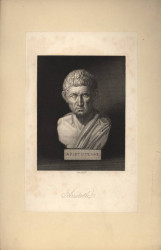Alexander Graves's collections
Women in 1950s America
<p>A learning resource to help develop students' ability to analyze an image and form an argument. The images in this collection are different portrayals of women in the United States during the 1950s. As you look through them, have your students think about these three key questions:</p><p>-What is being shown in the image?</p><p>-How is the woman represented in the image? Use concrete details from the image.</p><p>-Does the image compare to modern representations of women? Why or why not?</p><p>The collection ends with a quiz that can either be used as assignment to gauge the students' ability to pull together their analysis into a conclusion or a class discussion.</p>
 Alexander Graves
Alexander Graves
7
What Makes a First Lady?
<p>In this collection, students will answer the question "What Makes a First Lady?" by comparing and analyzing images of various First Ladies. They will also think critically about their definition of the First Lady as compared to that of the President and the differences in medium (painting, photography, video) artists use to represent a First Lady. One of the final activities will require students to find an image of a First Lady not shown in the collection to test their definitions. </p><p>This activity is based on the "Reading Portraiture" Guide for Educators created by the National Portrait Gallery. The guide can be found at the end of the collection. </p>
 Alexander Graves
Alexander Graves
12
What is Kwanzaa?
<p>In this activity, students will learn about the background and cultural significance of the holiday Kwanzaa through an an analysis of various resources:</p><p></p><ul><li>The collection begins with several images related to Kwanzaa. By looking through each of the resources, students can gain a deeper understanding of the holiday. Each image contains text about different parts of Kwanzaa and quiz questions to encourage further thoughts and reflections. </li><li>A resource from the Kwanzaa Planning Committee is featured after these resources to further discuss practices and principles related to the holiday.</li><li>Then, they will compare and contrast them with an image representing Christmas and another representing Hanukkah.</li><li>The final activity has the student upload a separate image and explore how he or she would use that image to describe Kwanzaa to someone.</li><li>The final resource includes an article from the Smithsonian Magazine that you can use to discuss the history of Kwanzaa with your class.</li><li>The resources include multiple choice and discussion questions.</li></ul><p></p>
<p>To read more information about Kwanzaa, please read the following official Kwanzaa website set up by the African American Cultural Center in Los Angeles, California: (<a href="http://www.officialkwanzaawebsite.org/symbols.shtml">http://www.officialkwanzaawebsite.org/symbols.shtm...</a>).</p>
<p>Tags: holidays, history, culture, African American culture, African American history, American history, American culture</p>
 Alexander Graves
Alexander Graves
14
Notable Events in 1939
<p>Ever since their first appearance in the 1939 release of <i>The Wizard of Oz</i>, Dorothy's ruby slippers quickly became one of the most iconic pieces of pop culture. But, did you know that other notable events also took place in 1939? In the same year that Dorothy walked down the Yellow Brick Road while wearing the ruby slippers, Germany invaded Poland, Batman first appeared in comics, Lou Gehrig retired from the New York Yankees, and much more. Explore this collection of images to witness key moments from 1939.</p>
 Alexander Graves
Alexander Graves
12
Moving Your Audience: Identifying Rhetorical Appeals in an Argument
<p>In this online activity, you will get a better sense of the four <strong>rhetorical appeals </strong>(<strong>logos, ethos, pathos, and kairos</strong>) The collection is organized as follows:</p>
<ul><li>The collection opens with<strong> an introduction to rhetoric and definitions of the four rhetorical appeals.</strong></li><li>Then, you will be tasked to<strong> examine</strong> four advertisements and<strong> identify</strong> one rhetorical appeal that is being used. For each image, <strong>you must use concrete information </strong>to explain your choices.</li><li>After looking through the four advertisements, you will then<strong> sort six additional advertisements</strong> into categories. You will categorize the images based on the rhetorical appeals. In the slide after the sorting tool, you will be asked to<strong> fully explain</strong> your classifications.</li><li>You will then be asked to <strong>reflect </strong>on the information learned through these activities, and how it may have changed your opinion on rhetoric.</li><li>In the final assignment for the collection, you will be tasked to<strong> upload</strong> an advertisement or public service announcement and analyze <strong>two rhetorical appeals</strong>. You may use an image or a video as your uploaded resource.</li></ul><p>Tags: rhetorical analysis, beginning writing, English 101, ENG101, on-line activity, student activity, online activity</p>
<p></p>
 Alexander Graves
Alexander Graves
11
Introduction to Primary and Secondary Sources
<p>In this activity, students will learn about the differences between <strong>primary and secondary sources</strong> by comparing and analyzing different resources from the <strong>U.S. Civil Rights Movement</strong>. </p>
<p>This collection provides ideas and strategies on how to<strong> spark discussions</strong> in the classroom about these types of resources, focusing primarily on <strong>students' interpretations of resources found here in Smithsonian Learning Lab</strong>.</p>
<p>Students will examine three different types of sources (<strong>documents, images, and objects</strong>). The activity consists of the following:</p>
<ul><li> In small groups, have your class <strong>examine the primary source</strong>, and have them summarize and report on its content, and discuss its <strong>strengths and limitations</strong>. </li><li>For each primary source,<strong> review the groups' responses as a class</strong>. </li><li>Then, have each group <strong>analyze the corresponding secondary source</strong>. Have them <strong>spot the differences between the primary and secondary source</strong>, and evaluate the reasons for using a primary source versus a secondary source. <ul><li>The primary and secondary sources in this collection focus on the same topic (the documents are about<strong> the Black Panther Party</strong>, the images feature <strong>Marian Anderson</strong>, and the objects relate to <strong>Rosa Parks</strong>)</li></ul></li><li>Near the end of the collection is the students' task to<strong> sort through sources to identify which are primary vs. secondary sources</strong>. </li><li>The final activity will call on students to <strong>reflect </strong>on the information that they have learned from the collection and ask them to think about how they would categorize digital resources such as texts and tweets as either primary or secondary.</li></ul><p>This collection and activity is based on <strong>the “Engaging Students with Primary Sources” guide from Smithsonian’s History Explorer</strong>, which can be found here: <a href="https://historyexplorer.si.edu/sites/default/files/PrimarySources.pdf">https://historyexplorer.si.edu/sites/default/files/PrimarySources.pdf</a>. The guide is also included at the end of the collection, and can be used to develop other activities and/or collections on the topic of primary and secondary resources.
</p>
<p><br /></p>
 Alexander Graves
Alexander Graves
18




